Route Optimization Software: Complete Guide
Everything you need to know about route optimization software all in one place. Learn how to plan better routes to boost efficiency in this in-depth...
Home > Blog > How to Choose Vehicle Route Optimization Software?
Delivery LogisticsAfter reading this, you’ll know what to look for, and how to choose the best vehicle route optimization software for your business.
Today, we’ll show you how to choose vehicle route optimization software.
There are a lot of options on the market. And we want you to make the right choice for your business.
It isn’t an easy task. There is a lot to consider. But we hope after reading this you’ll have a much better understanding of what to look for.
Vehicle route optimization software is a type of routing and fleet management software that automates the route planning process.
It enables users to find the most efficient vehicle paths (or routes) to various destinations (pick-ups and drop-offs) across the supply chain.
But it’s also so much more than that.
All route optimization software relies on complex algorithms. These routing algorithms allow the tool to calculate multiple potential routes based on various parameters, and find the best path for your vehicle in a matter of seconds.
Nowadays, most solutions are SaaS vehicle route optimization software. And since they adopt a cloud-first approach to delivery logistics, all first and third-party information is generated live, like maps, roads, and streets.
And thanks to geocoding, the software has minute-by-minute updates for all of the data, including the position of vehicles on the map (if it’s integrated with an on-board system).
Now that you know what it is and how it works, let’s take a look at why it matters.
What makes vehicle route optimization unique is that it’s tailored to vehicle management.
The software allows you to plan routes by mapping multiple delivery stops for multiple vehicles and fleets, but also to:
All of this makes it easier for you to take a granular approach to manage fleets that contain vehicles with specific roles.
Typically, you’d want to know what tasks to assign to semi or tractor-trailer trucks (e.g. long-distance distribution) vs. vans and caravans (e.g. last-mile delivery).
And depending on the industry, you may operate specialized vehicles.
In an uninterrupted pharmacy delivery, you need to know what vehicles can distribute specific medicines.
In a grocery delivery, you’d want to assign the delivery of perishable goods to cold trucks, rather than regular vehicles. And so on.
If you’re interested specifically in this topic, here’s our definitive guide to grocery delivery software.
But the software is becoming more and more indispensable in last-mile logistics.
The state of delivery in time of the coronavirus is making it clear that companies must adapt to the new conditions of the last mile.
Curbside delivery, click & collect, same-day delivery, in-store pickup and delivery are part of the new normal.
And if companies wish to keep up with these changes, they need to adapt, speed up, and automate their delivery logistics.
Technically, you need to initiate the digital transformation of your last-mile delivery.
In fact, 87% of business leaders believe that the digitalization of vital operations is a top priority, according to a Gartner report.
The bad news is that only 40% of companies have initiated the transformation.
And leveraging scheduling and route optimization software is unquestionably a major part of this transformation.
If you think about it, planning delivery routes is usually a difficult and labour-intensive task. But using just any old solution doesn’t cut it anymore.
Yes, navigation apps can help you to plan simple routes. But what happens when you have to plan routes that aren’t only longer (in terms of distance) but also include multiple stops?
And the complexity of the modern last mile means you need to think about a whole host of other things, as well.
Things that include vehicle types, speeds, volumes, working times, stopping times, cargo loads, and so on.
That’s where route optimization software steps in.
Let’s see how it can help you overcome these challenges.
Companies normally consider route optimization delivery software as a simple route planner. Which allows them to calculate the shortest distance between points A and B.
However, an efficient route planning solution is much more than just figuring out the best path from A to B.
Instead, vehicle route optimization software is an end-to-end logistical tool that has fleet and delivery management capabilities – all in one.
That means all you need to have is one tool to manage multiple elements of the entire delivery ecosystem.
Vehicle route optimization software has great potential to give you a quick return on your investment.
At one end, the software helps you to automate the route planning process. That makes this task much easier and faster to complete.
You no longer have to rely on a professional route planner to perform these tasks. Instead, you can train anyone on your team to handle this responsibility.
That ensures drivers always follow optimal routes when in the field, regardless of whether your dedicated route planner is at the office or not.
And simply because your drivers are using optimal routes to complete drop-offs they are reducing travel times, wait times, and fuel consumption.
Not to mention, they are boosting key metrics in delivery logistics, like the number of drop-offs and on-time delivery.
All of this cuts a lot of operational waste.
At the other end, it improves the performance of your delivery fleet.
Which means you increase the number of deliveries your business can handle (even when demand exceeds your capacity). And more deliveries always means more profit.
But there’s more. So let’s take a closer look at the output.
“Route optimization results in approximately two additional jobs per driver per day, or more than 330 extra deliveries per day.”
One of the major benefits of route optimization software is enhanced productivity.
Some companies even choose to use route optimization to boost productivity rather than focus only on reducing fuel costs.
Route optimization is always way more efficient than simple manual transport management, delivery scheduling, or planning. Simply put, it’s faster and gives better results.
So, you need to ask yourself: Are you still manually planning logistics operations?
If you are, then you’re missing out on a lot of chances to reduce additional waste of resources.
For example, you can maintain optimal fleet efficiency by downsizing it or redeploying vehicles from one fleet to another.
The reduction of the size of your fleet increases the number of deliveries or appointments each driver makes.
That raises the route density (number of stops per route) and significantly cuts the cost per each delivery.
And vehicle route optimization goes beyond that by guaranteeing that you make the best use of resources you have at your disposal.
Specifically, it improves vehicle utilization, which means that you can assign more cargo to each vehicle. Which additionally reduces the cost per delivery.
And since you can track vehicles in real-time, you can also address the problem of vehicle idle times.
That makes it easier to downsize the fleet, reprimand drivers (in case of idleness), or notice opportunities to plan better delivery schedules.
Safety always comes first.
Route optimization software is meant to decrease the times that vehicles spend on the road. And that automatically improves safety.
While on the road drivers have to complete different turns which often includes U-turns.
The more U-turns a driver has to make the higher the chances of delays and accidents.
With route optimization software, each time a driver chooses a destination, the software can plan a route with minimum turns (and even without turns at all).
Another problem for drivers is the weather. In fact, statistics say that over 22% of accidents are weather-related.
But thanks to vehicle routing software, you can use the system’s API to integrate with third-party apps to track weather reports and road conditions.
In doing so, you can add those parameters when planning routes, as well. And prevent drivers from ever taking unnecessary risks.
Software always chooses the most cost-effective routes, which cuts costs and saves you money on vehicle operating expenses.
For example, vehicle route optimization software can cut fuel costs up to 30%, since its main focus is on reducing travel time.
When vehicles spend less time on the road, that automatically reduces your maintenance costs, as well.
And when vehicles remain in peak condition more often, there is less need to service them.
All you need to do is schedule regular tune-ups. But these tasks also take less time.
So, using this type of software won’t only extend the service life of each vehicle, but actually extend their operating range (i.e. time completing deliveries).
Delivery route planner or a delivery routing software is the best last-mile delivery software solution.
Delivery routing software is usually accessible via the web which allows users to log in straight into their account on the browser via the provider’s website.
In this case, we’re talking about subscription-based delivery route planner software.
For any real-time delivery tracking software, this is an essential parameter. Simply because you won’t need to install, maintain, or update anything on the desktop.
The provider handles all systems updates and maintains the software remotely. And when a new upgrade roll-out you have immediate access to it.
So a web-based SaaS solution allows you to start optimizing routes as soon as you log in and access the system’s dashboards.
Vehicle route optimization software allows you to plan multiple routes regardless of how many vehicles you have in your fleet.
The biggest benefit here is, of course, that you don’t have to manually plan delivery routes for each vehicle.
That might not seem like a problem if you own one or two vehicles. But mapping just three more routes is a considerably more time-consuming ordeal.
Now imagine that you have even more vehicles, spread across multiple fleets, covering different delivery areas. At this point, the task seems herculean for any route planner.
But software automates this process. Instead of hours or days, vehicle route optimization software can calculate hundreds of routes for hundreds of vehicles in just a few seconds.
This makes it invaluable in any modern delivery operation.
All of the previously mentioned routes are located on the software’s main dashboard. Which gives you complete control and visibility over all vehicles, routes, and tasks across the entire last mile.
To get a better idea of how it works, here’s how eLogii can optimize your routes:
Once you input all of the vehicles, vehicle capacities, depot locations, and add the pick-ups and drop-offs (dates, times, and locations), all you do is click the optimize button.
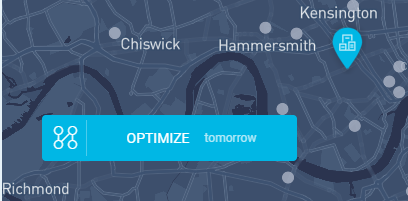
In a matter of seconds, the system calculates and generates the routes as paths on the main map.
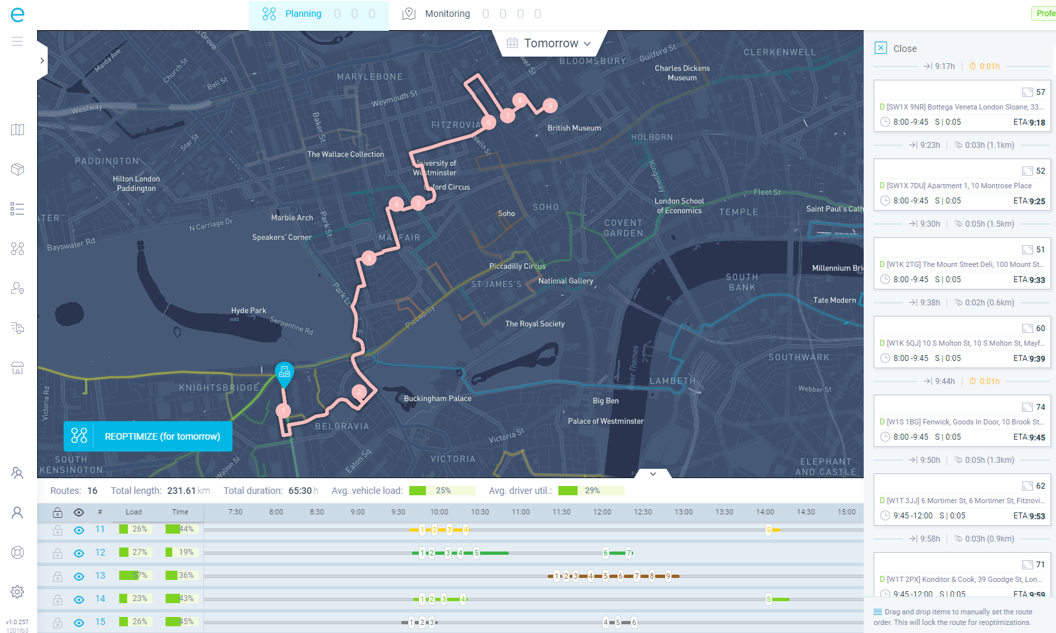
The colour of each path represents the different route for each vehicle.
The dots on each route are tasks or destinations (drop-offs and pick-ups) the vehicle has to reach.
The pins represent your supply depots.
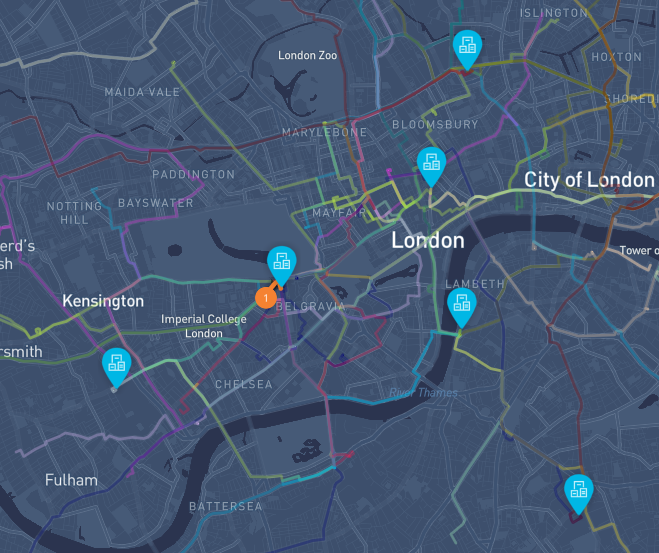
The vehicles themselves move on the map in real-time.
So, you have complete visibility over every aspect of the delivery operation, both at the granular and holistic level.
And at any point, you should have the ability to manually change any part of the route or schedule.
For example, assign a specific driver to a specific location. Which eLogii allows you to do.
A vehicle route optimization system should manage services in real-time, but also track the progress of every vehicle on each route.
Usually, this would involve a driver contacting dispatch to submit a proof of delivery, and handle some kind of paperwork.
With software, reporting is automated, as well.
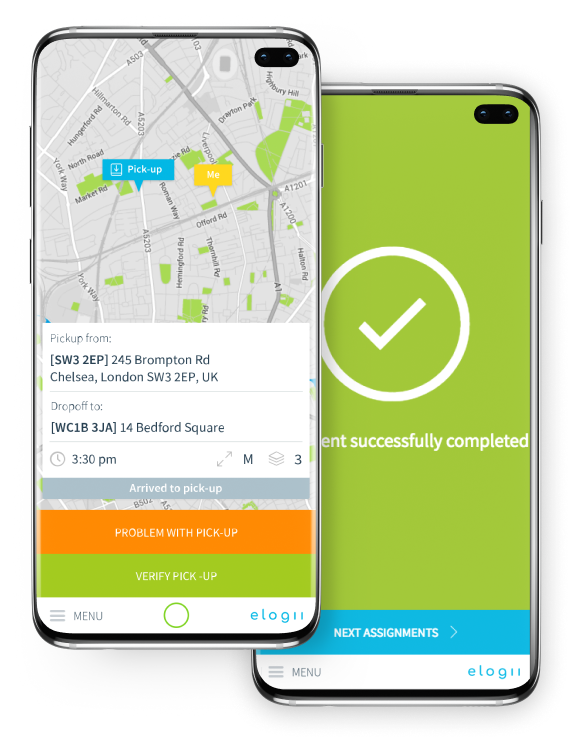
Once a driver has successfully arrived at a destination, the customer can sign the delivery confirmation.
Typically, a customer can do this with their smartphone using several options, such as:
An electronic proof of delivery looks like this:
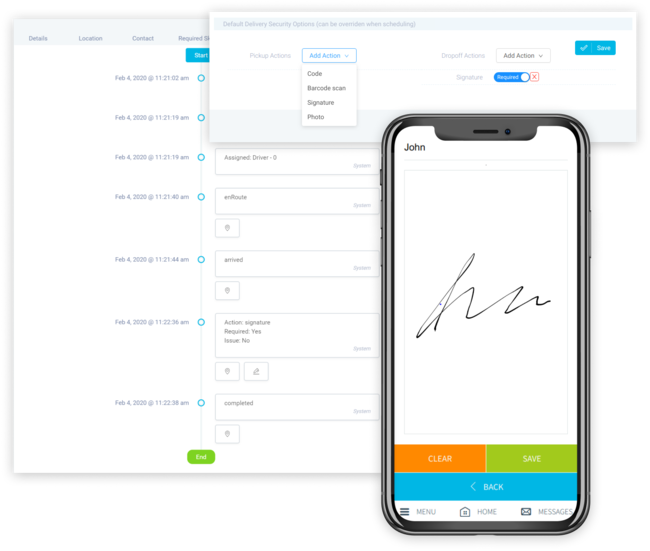
After the ePOD (electronic proof of delivery) is submitted, the driver can return to his vehicle, and move on to the next address. While the system marks the delivery as completed and makes it visible on the dashboard.
And since the software operates on the cloud, the received data is easily stored and always accessible. Which makes evaluating performance and customer data using analytics much easier than with pen and paper.
Finally, all of this has to happen fast. The modern last-mile delivery demands speed and all these operations, including the optimization of routes, has to happen at a moments notice.
Considering that fleet managers and drivers have to deal with a lot of deliveries, quick processing helps them organize and execute each delivery efficiently and with pinpoint accuracy.
The best vehicle route optimization software should optimize routes in a few seconds after you’ve clicked the button.
If the request takes a few minutes then this delivery management system is a complete waste of your time and money. And you should look elsewhere.
But we can help.
We have everything you need to start improving your delivery.
Everything you need to know about route optimization software all in one place. Learn how to plan better routes to boost efficiency in this in-depth...
Looking for a route optimization solution for your business? Here are 7 essential components you mustn’t overlook if you want the best route planner.
This is a guide about how to optimize route planning. If you want to plan efficient routes, spend less time doing it and cut costs, then this is for...
Be the first to know when new articles are released. eLogii has a market-leading blog and resources centre designed specifically to help business across countless distribution and field-services sub sectors worldwide to succeed with actionable content and tips.
